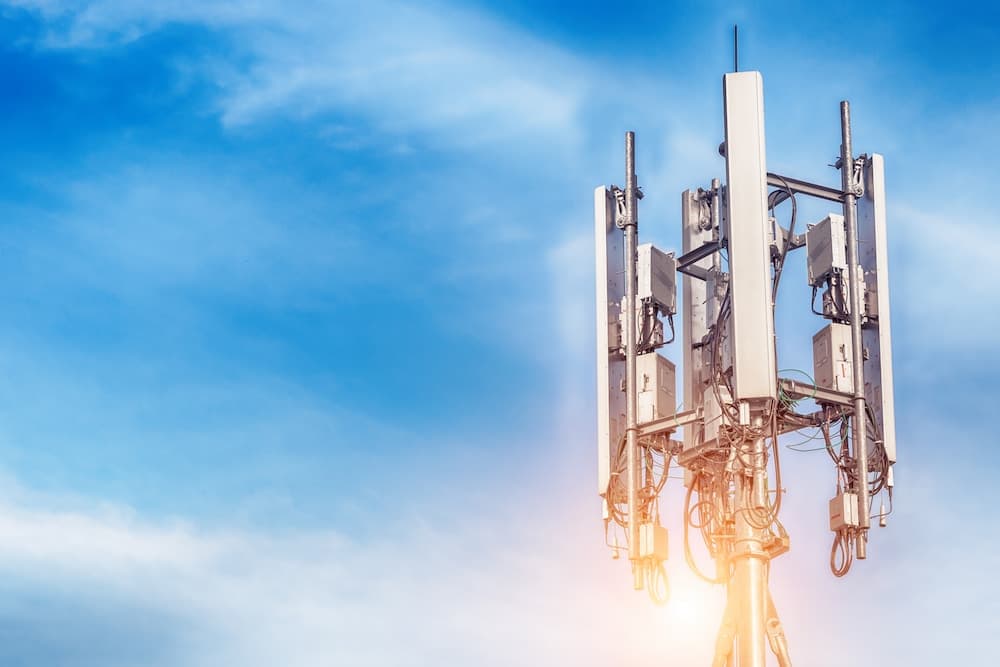Article Highlights
- 5G technology explained
- Effects on Real Estate Market
- Effects on Site Owners

Cell phone carriers spending billions to drive excitement around 5G. Learn how this will affect your business:
Cell phone carriers are spending billions of dollars to make sure you and everybody you know are all excited about 5G. The benefits will be terrific – faster download times, more throughput, and much more reliable and pervasive connectivity. All to support an astonishing array of connected devices and services. No more “connection lost because of poor connectivity” just when you are expected to speak on the Zoom call. We already have, and will have much, much more of, smart cities, smart cars, smart offices, smart factories, smart roads, smart everything. More, smarter, better.
What does the advent of 5G mean for the broader world of real estate?
One of the curious features of the radio frequency spectrum that 5G utilizes is that it is different from what we have been using up until now. The wireless industry has effectively run out of the standard spectrum and the carriers have bought – for tens of billions of dollars– what is called millimeter-wave spectrum.
This spectrum behaves differently than the frequencies we currently use for cellular service. It can carry much more data at much faster speeds. Very good things. But the hops – the distance it can carry this data – are much shorter. So, what does this mean? Many more sites! How many? In a recent op-ed in the Wall Street Journal, Eric Schmidt, the former Google CEO, points out that China is trouncing the US in 5G development, with almost 10 times (1 million versus 100,000) as many 5G base stations. This implies that to catch up to China, allowing for differences in population size, the US will need over 1 million new sites, roughly 3 times what we have today. For real estate owners that have properties that fit the basic requirements for cell sites – elevation, permitability, power, fiber and the like – this can only be a good thing. For carriers, this means a whole lot of new installations at a significant cost.
What does this mean for you as a cell site owner with a wireless lease on property you manage or own?
Well, it depends. It’s quite likely great news. First, it means that your tenant will probably have every interest in keeping their site on your property active and continuing to pay rent. Depending on what kind of property you own, what kind of cell site it is, and what kind of lease terms it has, it could also mean that a new tenant might be interested in installing on the site, which could (although not necessarily) mean more rent. Rent security and growth, what’s not to like? And, if you own other properties that might be of interest to carriers, this could mean a brand new cell site lease and additional rent.
All good. Is there a downside to this picture?
As always, there is. The carriers spend billions of dollars just on advertising, which is why you know about 5G in the first place. They also spend many billions of dollars more on spectrum, on equipment, on upgrading and servicing sites, sales and customer service, and, yes, on your and other lease holder’s rent. And then there’s that million new sites they need to build. Are they interested in reducing costs and improving their business? Of course! Are all sites profitable for them? Of course not! Not all commercial real estate is profitable. Not all retail outlets, not all restaurants, not all hotels and, increasingly, not all office buildings are profitable. The same is true with cell sites. So it could be that your site is one of those unprofitable or marginally profitable sites. You can rest assured that the network operators are working hard to solve this problem. Legacy 3G networks are being shutdown. The full impact of site consolidation from network acquisition is only now being felt. Carriers need to recoup their enormous investments and pay down their debt.
How can you know if your site is profitable and desirable or not?
From a 30,000 foot perspective, it roughly follows the laws of general real estate. The more people or uses a site services relative to the cost of operating the site, the more valuable it is. But from a ground level view, all sorts of things could affect that picture, starting with the lease terms and permitting conditions, not only for your site, but those nearby. Many other additional variables – fiber, power, geography, market usage, strategic priorities of the carriers – will affect the profitability of any given site.
What can you do to learn where you stack up and if you are missing out on opportunities to protect or better grow your rent?
Partner with an expert. We at Symphony have been in the wireless industry for decades and are leading investors in cell site leases across the country. It is our business to know the value and risk profile of cell sites. We will assess your site for current risk and future potential value and come up with a plan that best suits your interests or needs. Our assessment should help provide you with a reliable view as to how your site fits in with the expected future of the cell site grid. And it just might be the opportunity you were looking for to capitalize your cell site rent stream.
DISCLAIMER
The foregoing case study has been fictionalized in certain respects to protect the identities of the parties. Past performance is not indicative of future results. Symphony Wireless does not provide tax, accounting of estate planning advice. Interested parties are encouraged to consult your own legal and tax advisors.
© 2025 Symphony Wireless